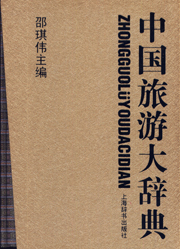China Tourism Dictionary

China Tourism Dictionary
Contents
Guide to the Use of the Book
Table of Entry Words
Text
Appendix
Regulations on Travel Agencies
Measures for Administration of Outbound Tours by Chinese Citizens
Regulations on Adiministration of Tour Guildes
The Opinions of the State Council on Speeding up the Development of the Tourism Industry
China Tourism Statistics Bulletin (2000-2010)
List of China's World Heritage
List of China's Historical and Cultural Cities
List of China's Excellent Tourist Cities
List of China's Best Tourist Citeis
List of China's 5A Tourist Attractions
Index
Entry Words Category Index
Entry Words Category Index in Foreign Languages
Guide to the use of the Book
I. The Dictionary is a large comprehensive reference book about the theory and knowledge of the tourism discipline. It includes 3086 entries of 27 categories, namely, tourism, leisure, travel agency, tourism reception, tourism transportation, tourism catering, tourism shopping, recreational activities, tourism safety, tourism insurance, tourism culture, tourism economy, tourism statistics, tourism enterprises, tourism influence, tourism resources, heritage, tourism planning, tourism science, tourism informatization, tourism destination, tourism area, tourism market, tourism laws and policies, tourism standard, tourism talent, and tourism organization.
II. Entry words are basic terminologies from tourism activities, tourism theories and the tourism industry, including important, frequently-used words and expressions of industry practice, professional teaching materials, and relevant tourism documents, as well as some ordinary words in modern social life closely related to tourism activities. As for characters and works, some authoritative works with powerful influence of the deceased or acknowledged by the academic circles are also included according to the circumstances. As for education and research institutes, those whose position is Vice Chairman of Education Branch of China Tourism Association or above can be included.
III. Based on the principle of objectivity, accuracy, conciseness and professionalism, the annotation is mainly depended on the assessment of academic circles. In case of dissent, public opinions or the representative opinion will be adopted as appropriate.
IV. Entry words' foreign language translation is annotated in a bracket; as for foreigner's name in the annotation, its original name is annotated in a bracket.
V. As for different definitions under the same entry word,  subentries will be adopted to recount.
subentries will be adopted to recount.
VI. As for the word with several names, the common name will be used as the main entry, while others reference entries.
VII. Generally, legal unit of measurement of China is used in the annotation.
VIII. Writer and approver for each entry are listed; main references are listed as appropriate, and the record format is in a simple manner.
IX. Appendixes include Regulations on Travel Agencies, Measures for Administration of Outbound Tours by Chinese Citizens, Regulations on Administration of Tour Guides, The Opinions of the State Council on Speeding up the Development of the Tourism Industry, China Tourism Statistics Bulletin (2000-2010), List of China's World Heritage, List of China's Historical and Cultural Cities, List of China's Excellent Tourism Cities, List of China's Best Tourism Cities and List of China's 5A Tourist Attractions.
X. Source of the dictionary is generally till 2010.
XI. The body's entry words are classified in a pinyin sequence, and there is an entry words table in the front of the book. Entry words started with digit or foreign language are placed in the "other" category at the end of the text. There are classified index and foreign language index of the entry words at the end of the book.
Editorial staff
